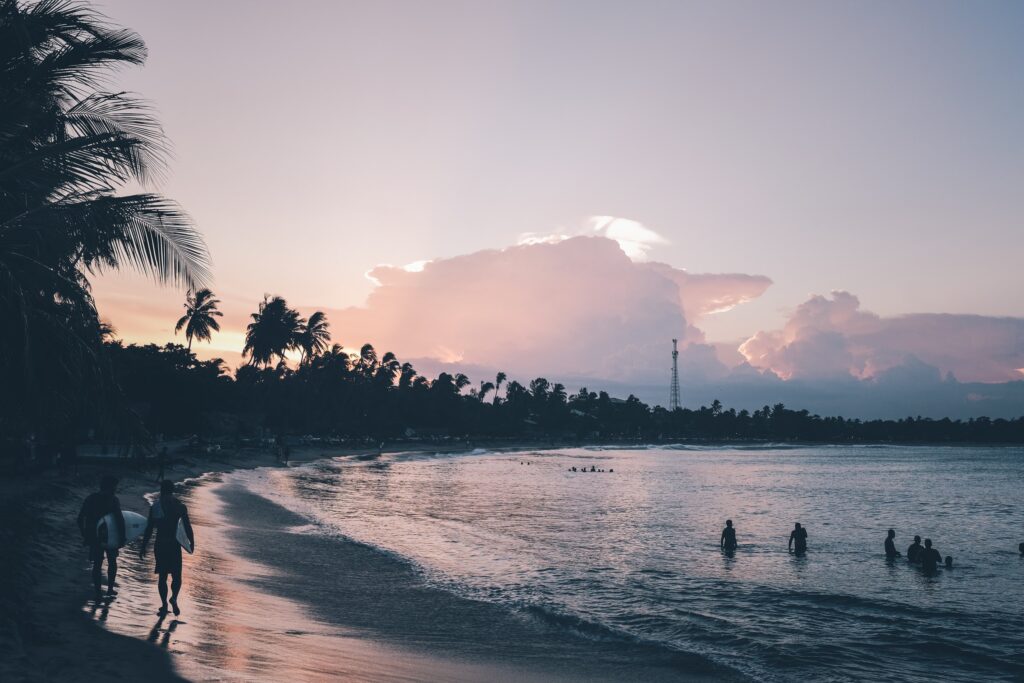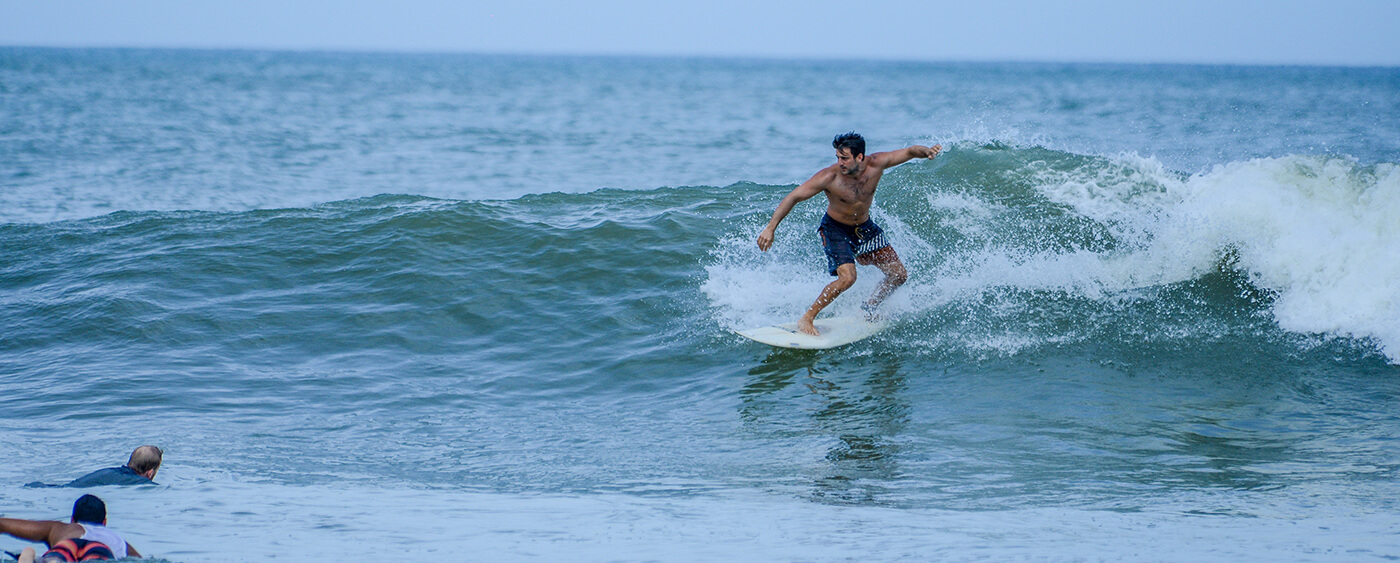Why choose Sri Lanka as a surf destination?

From beginners to experts, this exotic island has the right choice of waves, easy access, and just the right tropical water to make it a surfer’s paradise!
- Sri Lanka’s coastal areas tend to have smaller and cleaner waves, being one of the higher latitude surf zones in the Indian Ocean. In the dry season, off-shore waves are about 2-6 feet high and even during the quiet period, you can often see glassy conditions for surfing in Sri Lanka.
- Sri Lanka enjoys tropical weather and warm water throughout the year. The equatorial sun gives an average air temperature of about 25-30 Degrees Celsius while the water temperature is at about 28 Degrees Celsius for the most part.
- The food in Sri Lanka is delicious and cheap! Indulge in tropical fruits such as papaw, banana, watermelon, mango, and pineapples for breakfast along with a ‘hopper’ (bowl-shaped pancake). A freshly brewed tea is not to miss! Lunch and dinner usually include the authentic Lankan rice and curry, kottu rotti, or string hoppers.
- In addition to surfing, Sri Lanka has a lot more to offer – culture, history and nature. Remnants of the pre-historic era of over 125000 years are still seen in ancient cities such as Anuradhapura and Polonnaruwa. Natural attractions such as wildlife at National Parks and lush greenery in the Hill country is to die for!
- Due to its diverse landscapes and rich culture, Sri Lanka has an itinerary suitable for the preferences of every traveler in terms of taste and budget. From honeymooners to families, to friends seeking an adventure, nature lovers, history lovers, and animal lovers – Sri Lanka has it all!
When and where can you find the best waves in Sri Lanka?
As a unique equatorial country, there are two monsoon seasons and two dry seasons in Sri Lanka. Let’s skip the weather jargon and put it in simple words – Sri Lanka has sunshine and good surf somewhere on the island at any point in time.
October – April is the dry season in the west and south west coast while April – October is when the east coast is dry. So, depending on what time of the year you want to visit, you can choose your surf destination accordingly.
Moving on to the important question – what are the waves in Sri Lanka like?
Never flat, always fun, and rarely scary! Perfect for beginners and intermediate surfers, there is an equal balance of beach and reef breaks. Sri Lanka has been a popular surf destination since the 70’s, boasting slabs, points, and good A-frame reef break setups. Let us now discuss a few places you should check out on your surfing holiday to Sri Lanka.
South Coast
Hikkaduwa has a left and right beach because it is broken up into the reef. Hikkaduwa has a popular beach break, with punchy peaks up and down, and lesser people to be found here, as most are on the reef. One could see this as a close-out or a smashable end section, also good for beginners. The crowd is often attracted to the A-frame reef break where predictable breaks are seen. While the lefts have a long lip, the rights can barrel.
Unawatuna has ideal waves for a beginner but sometimes the order of waves is interrupted due to the neighboring man-made reef. But 120meters from the main beach is Dalawella – a left breaker over a coral reef, rocks, and urchins.
Ahangama has several waves to suit all surfing levels. South of the Ahangama fishing poles is the Rajith surf point; an intermediate reef break, a peeling classic A-frame, holding up to 5ft with about 350m rides.
Midigama is now a popular surfing spot, still on the quiet side, but has four consistent surf breaks that are within walking distance. Lazy Rights is perfect for beginners – a weak and long wave that breaks over a deep reef. Lazy lefts are more for a slow left-hander. Ram rights offers a barrel on a mini slab, along with a nice shoulder turn. Finally, there’s the plantations and coconuts spot which is something between the rams and lazy’s, ideal for intermediate surfers who prefer reef breaking.
Weligama is the perfect beach to hold surfing lessons. Massive and consistent, this beach has produced the best of surfers. Off island waves work in stormy conditions and a paddle-able outer reef is helpful when wind conditions go haywire.
Mirissa has a fun right-hand point break over shallow reefs full of urchins, making it a popular surf destination in Sri Lanka.
East Coast
Arugam Bay, also known as surfer’s paradise, is the surf destination that brought Sri Lanka onto the surfing map. The Arugam Bay beach is made up of several right-hand points, in-fact some of the longest in the world, which are rarely scary big, and never flat when in season.
How to avoid surf crowds
- Know when to go: in Sri Lanka, April, May, July, August, and December are months when locals venture out the most. Keeping this in mind, study your calendar, target your location, study the monsoon seasons, and figure out a time early in the dry season or towards the trail end of the dry season to avoid most crowds.
- Explore, explore, and explore more: if you are an advanced surfer, talk to a few locals, check out the swell spots, and venture out in a tuk tuk to explore the off the beaten path!
- Off peak hours: figure out the off-peak hours and outsmart your fellow surfers. Of course, this could mean having to bear the mid-day heat or the jeepers that come with pre-dawn sessions and moonlit surf… but hey, why not?
Where to stay?
As a general rule of thumb, you get what you pay for. So, depending on your budget, you could find a room on the beach for £5 or an exclusive luxury hotel for £300, the tourism industry in Sri Lanka caters to everyone! If you are travelling with a large group and kids maybe, it is advisable to do your research and book an appropriate accommodation in advance. But solo travelers could simply show up and take a look around to find something suitable.
What to bring on a surfing holiday to Sri Lanka?
- Your surf board
- Multiple swimsuits
- Sun protection for your skin
- Beach towel
- Wetsuit
- A water-resistant daypack
- Surf accessories
- First-aid kit
- Alarm
So, pack up your stuff and get on a flight to Sri Lanka to enjoy a thrilling surfing holiday in Sri Lanka!

